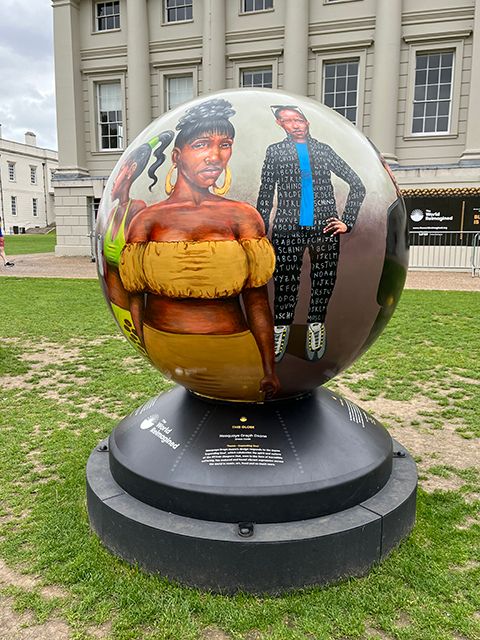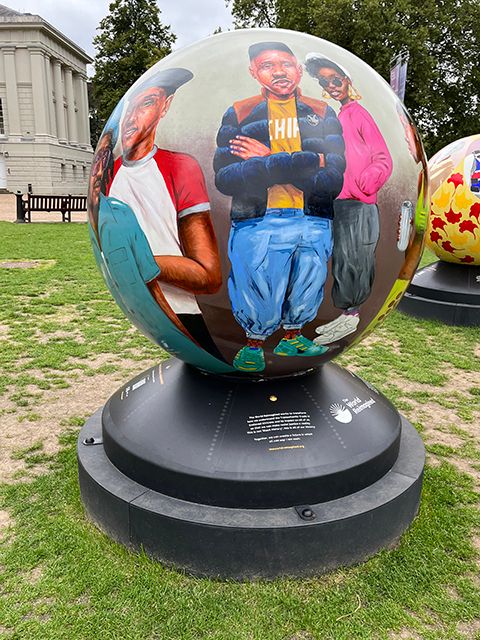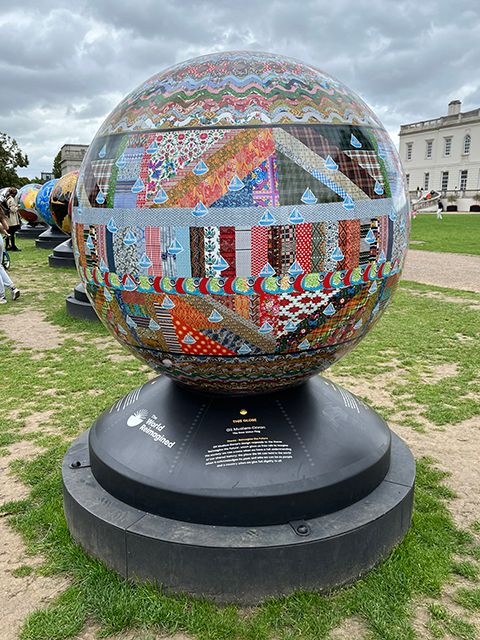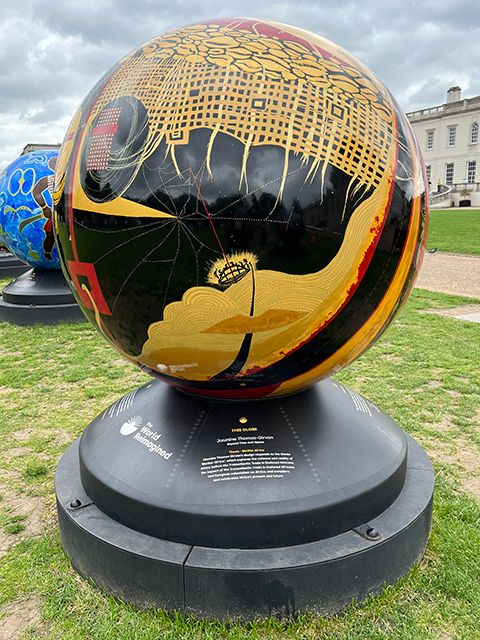The World Reimagined: Part Two
If you missed yesterday's post which introduced The World Reimagined project and what it aims to do please click here.
The World Reimagined created 103 unique globes across the UK exploring the history, legacy and future of the Transatlantic Trade in Enslaved Africans through the work of incredible artists.1
I was fortunate to see the 36 globes on exhibit outside the National Maritime Museum, Greenwich.
The globes, each created by a different artist, are grouped into the themes of: Mother Africa, The Reality of Being Enslaved, Stolen Legacy: The Rebirth of a Nation, Abolition & Emancipation, A Complex Triangle, Echoes in the Present, Still We Rise, Expanding Soul, Reimagine the Future and Community.
We commence today's showcasing of these fascinating and very powerful globes with a creation from the theme of Expanding Soul titled Dress Code by Neequaye Dreph Dsane.

Artist's Statement
My globe design is a celebration of the style and dress of Black people in Britain over the last half century; since the Windrush Generation, one of the first large groups of post-war Caribbean migrants to the UK in the 1950s. It is a visual snapshot depicting six cultural turning points over this period; Calypso, Reggae, Hip Hop, Dancehall, Jungle and Grime. These musical genres and their respective dress codes reflected the social and political ideals of the day.1
A broad range of expression included our desire to be seen in a hostile environment, Black consciousness or symbols of wealth and status. Despite not always receiving the reverence it deserved and dismissed in recent times as materialistic or frivolous, Black British music and style continues to permeate mainstream British culture at the highest levels. Personal style is a reflection of lifestyle.1
Our style is a nuanced expression of identity that draws from the melting pot of rich British and diasporic influences. As our styles continue to evolve, what is constant is our desire to express pride, strength and a commitment to making something out of nothing.1
This is another view of Dress Code by Neequaye Dreph Dsane.

The next globe to look at is titled The New Union Flag by Gil Mualem-Doron and has been classified into the theme of Reimagine the Future.

Artist's Statement
The New Union Flag (NUF) reimagines the Union Jack and celebrates the communities that have contributed to the UK’s cultural legacy. Recreated with fabric designs from all over the world, the New Union Flag transforms the traditional Union Jack from an archetype of uniformity into a dynamic and celebrational ongoing performance of diversity. Whilst this flag started as a reflection of the UK’s colonial legacy, its design is ever-changing to reflect the ongoing changes in the makeup of this nation.1
For The World Reimagined, the 2D Flag was redesigned to fit the globe sculpture and the Reimagine The Future theme.1
From 2015, the New Union Flag has evolved every few months with the contributions of participants from various national and ethnic backgrounds. For three years it has engaged thousands of people through gallery exhibitions – Turner Contemporary, Tate Modern, South Bank Centre, People’s History Museum Manchester, Liverpool Museum, The Jewish Museum, Rich Mix and more – as well as through numerous cultural events, school visits, festivals, rallies, and workshops.1
The New Union Flag project includes photoshoots and video-recorded conversations with people who would like to see it adopted as the national flag – as well as others who don’t. The flag was part of social gatherings and demonstrations and was used in public space interventions. The New Union Flag project is in constant development and invitations for exhibitions, public talks and workshops are welcomed.1
The lasty globe we will look at today is by Jasmine Thomas-Girvan titled Beyond Time and Space in the theme of Mother Africa.

Artist's Statement
Beyond Time and Space celebrates the fecundity of African knowledge systems and imagination.1
Akan Gold weights, Ibeji-twin births, murmuration, cowrie currency, obus structures, navigation by stars, and Anansi together signify Africa’s rich cosmology. They embody the interwoven connections between the land, spirituality, craft traditions, biological hybridity, and even modes of exchange. Synergistically they stand across time, space, and species, crystalized in a philosophy that privileges harmony between man, nature, and celestial realms. This offering is a retrieval- evocations of Africa -an invitation to a pathway to greater awareness of our magnificent ancestry. Awareness ultimately leads to our healing.1
We honour the past to transform our lineages backward, to grow, and create new pathways forwards. I hope that awareness of these unique elements of our potent legacy in the words of Kamu Brathwaite “will lead the community more easily into a wholesome relationship with the Ancient future and the approaching past.”1
Below are a few expanded themes:
IBEJI-TWIN BIRTHS-Fertility-
Carved wooden Twin figures at the British Museum led me to the discovery that the Yoruba peoples from the Congo region have the highest incidence of twin births in the world. I find this telling in a world of decreasing fragile fertility…1
An above-average number of twins is born on the African continent compared to other parts of the world. The Yoruba people as well as other African cultures attribute supernatural origins and spiritual power to twins. As a result, twins are regarded as extraordinary beings protected by Sango, the deity of Thunder. They are believed to be capable of bestowing immense wealth upon their families or misfortune to those who do not honour them.1
The two figures on the globe stand like sentinels to commemorate this astonishing biological gift.
AKAN GOLD WEIGHTS
Akan Gold weights were used as a measuring system by the Akan people of West Africa. These elegant objects were essential tools for trade in West Africa until the end of the 19th Century. Beyond their practical application, the weights are emblems of tradition and social values carefully crafted to illustrate proverbs and folktale wisdom. They illuminate the intricacies of a complex society, keeping memories of battles, myths, and legends alive as an art form. Their significance transcends their utility and reflects wider Asante spiritual beliefs. They show how materials, ideas, and technology have been exchanged between different parts of the African continent and Europe for centuries.1
One of the main motifs on the globe, a replica of one of the gold weights, shows people on a boat traversing the vast ocean. This celebrates the insight of Ivan Van Sertima that Africans traveled across the oceans arriving in the Americas long before they were transported on slave ships.
‘They came before Columbus’ outlines these extraordinary voyages. African advances in agriculture, mathematics, arts, engineering architecture, writing, medicine astronomy, and navigation made audacious journeys across vast oceans physical and possible.1
ANANSI and the architecture of the web.
As engineers of possibility, Africans evolved their own advanced guidance systems to endure and survive treacherous crossings. This was a dialogue with the stars but more importantly, supported by ‘constellational thinking’ central to African cosmology and life. Anansi, the Spiderman-Akan God of Stories, Wisdom, and Knowledge and a central figure in West African folktales not only survived the voyage across the oceans from West Africa but consolidated African cosmology in the daily lives of Africans in the New World in our oral traditions. Anansi is best known for his ability to outsmart and Triumph over powerful opponents through his use of cunning, creativity, and wit.1
Anansi’s domain – the spider’s web has a complex and mysterious design that has exceptional strength and flexibility. It is stronger than steel almost invisible yet can survive winds that exceed hurricane strength. The psyche of Africans who survived the Transatlantic Trade in Enslaved Africans, like the spiderweb, is resilient and indestructible. Like the strand of a spider’s web, it is made up of infinite diaphanous strands of Ancestral frequencies. I believe that our resilience and identity continue to be nourished by this ancient wisdom. It reverberates in our music, spiritual practices, food, architecture, and in every imaginable facet of Life.1
MURMURATION
Murmuration is an extraordinary natural phenomenon where a huge mass of black sweeps across the sky. This spectacular movement is of birds moving in concert, swirling, surging, and constantly changing form. The shifting patterns and rhythm of the birds are a remarkable force of nature. The birds fly in intricately coordinated patterns through the sky to maintain cohesion as a group in highly uncertain environments to protect the collective flock. Black is the colour of darkness and mystery, the unseen and unknown. A bird in flight can represent the connection between the physical and the spiritual.” Birds of a feather flock together” describes a simple survival instinct, a strategy similarly exercised by the people of Africa. This unity is manifested in the principle of UBUNTU – I am because you are. Ubuntu is an eternal African Philosophy of ‘Oneness’ – this oneness is an understanding of the interconnectedness of all life.1
COWRIE SHELLS
The cowrie shell was one of the most successful and universal forms of currency in the world. In West Africa, the shell developed a deeper symbolic and ritualistic meaning throughout history that is still recognized in modern cultures. The size, shape, and minimal weight of the small white shells made them suitable as a form of exchange. Cowrie shells hold great symbolism. In African legend, it represents the protective power of the Ocean Goddess Yemaya. Their rounded shape is attributed to their connection to fertility, and the slit where the shell curves inside of itself has been said to look like a black pupil, making it popular as a symbol of protection against the evil eye. It is used as a divination tool in traditional spiritual practices.1
The World Reimagined aims to transform how we understand the transatlantic slave trade and its impact on all of us, in order to make racial justice a reality.2
"We are living in a key moment for racial justice and it calls on us to courageously face our shared history with honesty, empathy and grace so we can create a new future in which all can say: I am seen."2
Tomorrow we will look at the last of the globes I saw but in the meantime if you have time please check out the official website for The World Reimagined by following the link below. This way you can also read the bio information on each of the artists.
THE WORLD REIMAGINED
Click HereCredits
1. theworldreimagined.org
2. rmg.co.uk/whats-on/national-maritime-museum/world-reimagined
